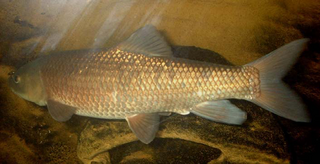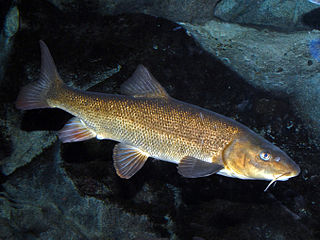
The Dalmatian barbelgudgeon is a European ray-finned fish species in the family Cyprinidae. It is the only member of the monotypic genus Aulopyge. The genus name is derived from the ancient Greek aulós + pygé, and thus means approximately "fluted tail-stem". The specific name honours the Austrian naturalist and diplomat Charles von Hügel. Though the genus was established in 1841, the species was only mentioned but not described at that time; that happened the following year, and in 1843, the frequently-seen misspelling huegeli was introduced. Many fish databases use 1843 as the year of description. The IUCN Red List uses 1842 and also has an explanation of the confusion here.
The Albanian barbel is a ray-finned fish species in the family Cyprinidae. It is often referred to as "Albanian barbel" in a literal translation of its scientific name.

The Ripon barbel is an East African ray-finned fish species in the family Cyprinidae. A huge barb, its maximum recorded total length is 90 cm (35 in).

The Algerian barb or Tunisian barb, is a ray-finned fish species in the family Cyprinidae. It is found in Algeria and Tunisia.

The Iberian barbel is a ray-finned fish species in the family Cyprinidae. It is here placed in Luciobarbus following the IUCN, but that genus is very closely related to the other typical barbels and perhaps better considered a mere subgenus of Barbus. This large barbel can grow to over 50 cm (20 in) long.
Luciobarbus graecus is a ray-finned fish species in the family Cyprinidae. It is here placed in Luciobarbus following the IUCN, but that genus is very closely related to the other typical barbels and perhaps better considered a mere subgenus of Barbus. Found in and adjacent to Greece, its closest living relative seems to be L. lydianus, which is found in the northwest of Asia Minor.

Luciobarbus graellsii is a ray-finned fish species in the family Cyprinidae. It is here placed in Luciobarbus following the IUCN, but that genus is very closely related to the other typical barbels and perhaps better considered a mere subgenus of Barbus. The Andalusian barbel was formerly included in L. bocagei as subspecies.
Luciobarbus guiraonis is a ray-finned fish species in the family Cyprinidae. It is here placed in Luciobarbus following the IUCN, but that genus is very closely related to the other typical barbels and perhaps better considered a mere subgenus of Barbus.

Barbus haasi, or the "Catalonian barbel", is a species of freshwater fish in the family Cyprinidae.

Labeobarbus intermedius is an East African ray-finned fish species in the family Cyprinidae. Like the closely related yellowfish, it is hexaploid. A large species, the maximum recorded standard length is nearly 50 cm (20 in). This species has a subspecies named Labeobarbus intermedius intermedius.
Barbus labiosa is a doubtfully distinct ray-finned fish species in the family Cyprinidae.

Luciobarbus microcephalus is a ray-finned fish species in the family Cyprinidae. It is here placed in Luciobarbus following the IUCN, but that genus is very closely related to the other typical barbels and perhaps better considered a mere subgenus of Barbus.

The Italian barbel is a species of freshwater fish in the family Cyprinidae, nearly related to the common barbel Barbus barbus.
Labeobarbus reinii is a ray-finned fish species in the family Cyprinidae. It is retained in the genus Labeobarbus. The IUCN for example notes that the taxonomy of this species is in need of revision.

The Andalusian barbel or is a freshwater fish species in the family Cyprinidae. It is here placed in Luciobarbus following the IUCN, but that genus is very closely related to the other typical barbels and perhaps better considered a mere subgenus of Barbus. The Andalusian barbel was formerly included in L. bocagei as subspecies.
Luciobarbus steindachneri is a species of cyprinid fish. It is here placed in Luciobarbus following the IUCN, but that genus is very closely related to the other typical barbels and perhaps better considered a mere subgenus of Barbus.
Luciobarbus is a genus of ray-finned fishes in the family Cyprinidae. Its members are found in fresh and brackish waters of southern Europe, northern Africa, the wider Near East, the Aral and Caspian Seas, and rivers associated with these. Several species in the genus are threatened. Most species are fairly small to medium-sized cyprinids, but the genus also includes several members that can surpass 1 m (3.3 ft) in length and the largest, the mangar can reach 2.3 m (7.5 ft).

Squalius valentinus, commonly known as the Valencia chub and the Levantine bagra, is a species of freshwater fish in the carp family Cyprinidae. It was first isolated from the Turia River in Valencia, hence its name. It is considered endangered. This species is differentiated from its cogeneratesa by having eight branched rays in its dorsal fin; eight branched rays in its anal fin; two rows of pharyngeal teeth on both sides possessing 2 and 5 teeth ; a wide caudal peduncle; its number of gill rakers; the number of scales in its lateral line; the number of scale rows above the latter; by possessing three scale rows below it; by having thirty-nine vertebrae ; showing large 4th and 5th infraorbital bones; a maxilla with a very distinctlt marked anterior process; exhibiting a frontal bone expanded at the middle; a wide neurocranium bone; the lower branch of the pharyngeal bone being robust; a large and narrow urohyal; as well as genetic differences (allozymes).
Squalius malacitanus, commonly known as the Malaga chub, is a species of freshwater fish in the carp family Cyprinidae. It was first isolated from the Guadalmina River in Málaga, hence its name. It is considered a vulnerable species. S. malacitanus differs from its cogenerate species by having 7–8 branched rays in its dorsal fin, 8 branched rays in the anal lateral line; the number of scale rows above its lateral line; possessing 3 scale rows below its lateral line; 38 vertebrae, 21 abdominal, and 17 caudal; large fourth and fifth infraorbital bones; maxilla without a pointed anterior process; the middle of its frontal bone being narrow, as well as its neurocranium bone; the lower branch of its pharyngeal bone is rather long; and the shortness of the inferior lamina of its urohyal bone.
The Kuban barbel is a species of ray-finned fish in the family Cyprinidae. It is found in the Kuban River to the Sea of Azov.













